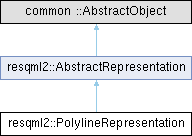|
| virtual | ~PolylineRepresentation ()=default |
| |
| virtual void | setGeometry (double const *points, unsigned int pointCount, eml2 ::AbstractHdfProxy *proxy=nullptr, resqml2 ::AbstractLocal3dCrs *localCrs=nullptr)=0 |
| |
| virtual bool | isClosed () const =0 |
| |
| virtual bool | hasALineRole () const =0 |
| |
| bool | isASeismicLine () const |
| |
| bool | isAFaciesLine () const |
| |
| virtual gsoap_eml2_3::resqml22__LineRole | getLineRole () const =0 |
| |
| virtual void | setLineRole (gsoap_eml2_3::resqml22__LineRole lineRole)=0 |
| |
| uint64_t | getPatchCount () const final |
| |
|
virtual std::string | getXmlTag () const final |
| |
| virtual | ~AbstractRepresentation ()=default |
| |
| class AbstractLocal3dCrs * | getLocalCrs (unsigned int patchIndex) const |
| |
| virtual common::DataObjectReference | getLocalCrsDor (unsigned int patchIndex) const |
| |
| virtual common::DataObjectReference | getHdfProxyDor () const =0 |
| | Gets the data object reference of the HDF proxy which is used for storing the numerical values of this representation (i.e. its geometry).
|
| |
| void | setTimeIndex (uint64_t timeIndex, eml2 ::TimeSeries *timeSeries) |
| |
| uint64_t | getTimeIndex () const |
| | Gets the time index of this representation in the associated TimeSeries. Be sure to first check that a TimeSeries is associated this representation by calling getTimeSeriesDor or getTimeSeries;.
|
| |
| eml2::TimeSeries * | getTimeSeries () const |
| |
| common::DataObjectReference | getTimeSeriesDor () const |
| | Gets the data object reference of the TimeSeries containing the time of this representation at a particular index. For now, this method only look for a TimeSeries at the first patch containing a point geometry.
|
| |
| std::vector< class AbstractProperty * > | getPropertySet () const |
| |
| void | setInterpretation (class AbstractFeatureInterpretation *interp) |
| |
| class AbstractFeatureInterpretation * | getInterpretation () const |
| |
| common::DataObjectReference | getInterpretationDor () const |
| |
| virtual uint64_t | getXyzPointCountOfPatch (unsigned int patchIndex) const =0 |
| |
| uint64_t | getXyzPointCountOfAllPatches () const |
| |
| virtual void | getXyzPointsOfPatch (unsigned int patchIndex, double *xyzPoints) const =0 |
| | Gets all the xyz points of a particular patch of this representation. xyz points are given in the local CRS.
|
| |
| void | getXyzPointsOfPatchInGlobalCrs (unsigned int patchIndex, double *xyzPoints) const |
| | Gets all the xyz points of a particular patch of this representation. xyz points are given in the global CRS.
|
| |
| void | getXyzPointsOfAllPatches (double *xyzPoints) const |
| | Gets all the xyz points of all patches of this representation. xyz points are given in the local CRS.
|
| |
| bool | isInSingleLocalCrs () const |
| |
| bool | isInSingleGlobalCrs () const |
| |
| void | getXyzPointsOfAllPatchesInGlobalCrs (double *xyzPoints) const |
| |
| AbstractRepresentation * | getSeismicSupportOfPatch (const unsigned int &patchIndex) const |
| |
| std::set< AbstractRepresentation * > | getAllSeismicSupport () const |
| |
| void | pushBackIntoRepresentationSet (class RepresentationSetRepresentation *repSet) |
| |
| void | addSeismic3dCoordinatesToPatch (unsigned int patchIndex, double *inlines, double *crosslines, uint64_t pointCount, resqml2 ::AbstractRepresentation *seismicSupport, eml2 ::AbstractHdfProxy *proxy) |
| |
| void | addSeismic3dCoordinatesToPatch (unsigned int patchIndex, double startInline, double incrInline, unsigned int countInline, double startCrossline, double incrCrossline, unsigned int countCrossline, resqml2 ::AbstractRepresentation *seismicSupport) |
| |
| void | addSeismic2dCoordinatesToPatch (unsigned int patchIndex, double *lineAbscissa, resqml2 ::AbstractRepresentation *seismicSupport, eml2 ::AbstractHdfProxy *proxy) |
| |
| void | getSeismicLineAbscissaOfPointsOfPatch (unsigned int patchIndex, double *values) const |
| |
| void | getInlinesOfPointsOfPatch (unsigned int patchIndex, double *values) const |
| |
| void | getCrosslinesOfPointsOfPatch (unsigned int patchIndex, double *values) const |
| |
| virtual void | loadTargetRelationships () override |
| |
A representation made up of a single polyline or "polygonal chain", which may be closed or not. See definition here: http://en.wikipedia.org/wiki/Piecewise_linear_curve.
BUSINESS RULE: To record a polyline the writer software must give the values of the geometry of each node in an order corresponding to the logical series of segments (edges). The geometry of a polyline must be a 1D array of points.
A simple polygonal chain is one in which only consecutive (or the first and the last) segments intersect and only at their endpoints.

 Public Member Functions inherited from resqml2::AbstractRepresentation
Public Member Functions inherited from resqml2::AbstractRepresentation Static Public Attributes inherited from resqml2::AbstractRepresentation
Static Public Attributes inherited from resqml2::AbstractRepresentation